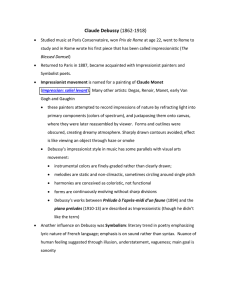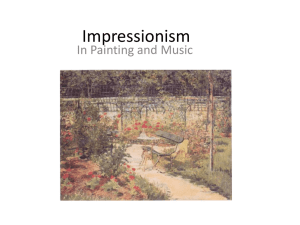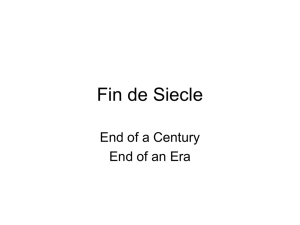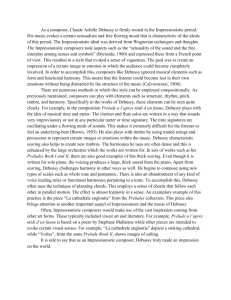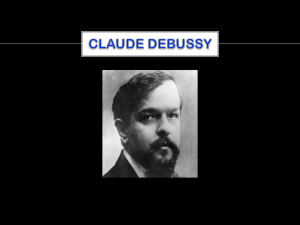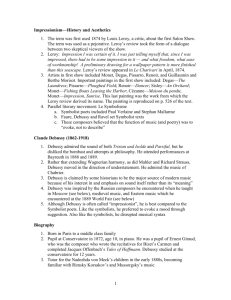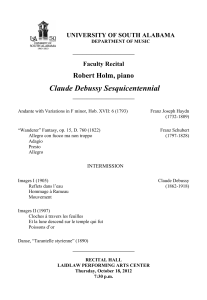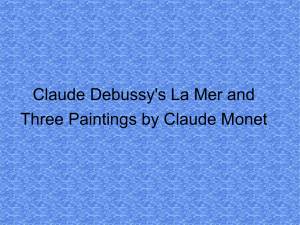History of Music, Mr. Robert L. Johnston develop?
advertisement
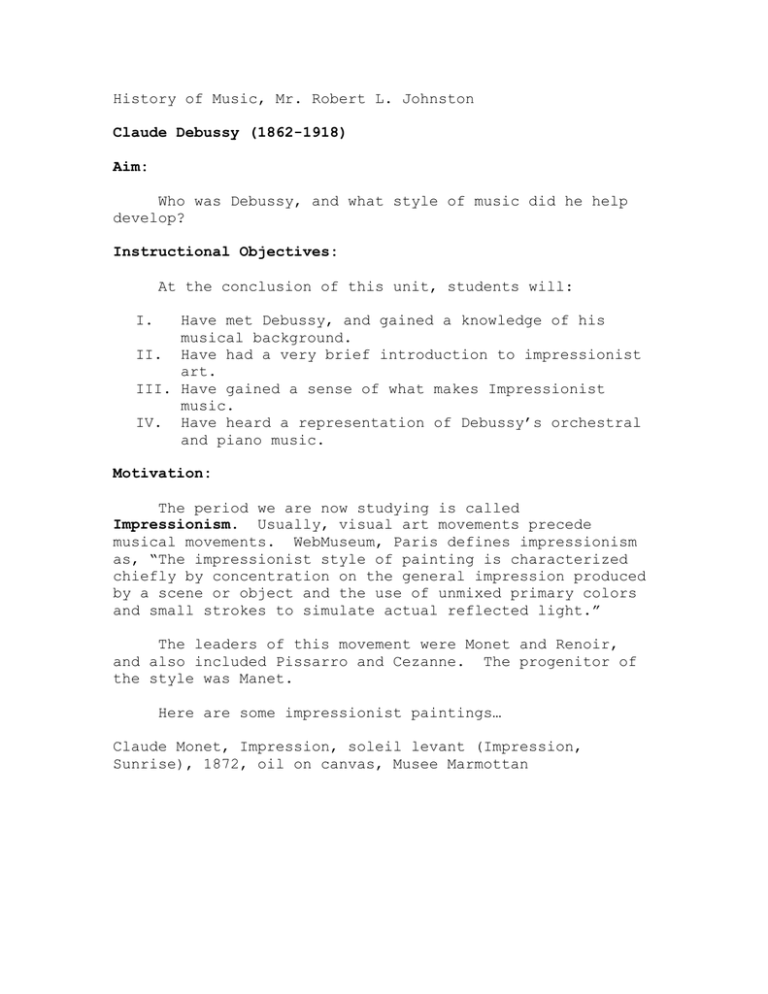
History of Music, Mr. Robert L. Johnston Claude Debussy (1862-1918) Aim: Who was Debussy, and what style of music did he help develop? Instructional Objectives: At the conclusion of this unit, students will: I. Have met Debussy, and gained a knowledge of his musical background. II. Have had a very brief introduction to impressionist art. III. Have gained a sense of what makes Impressionist music. IV. Have heard a representation of Debussy’s orchestral and piano music. Motivation: The period we are now studying is called Impressionism. Usually, visual art movements precede musical movements. WebMuseum, Paris defines impressionism as, “The impressionist style of painting is characterized chiefly by concentration on the general impression produced by a scene or object and the use of unmixed primary colors and small strokes to simulate actual reflected light.” The leaders of this movement were Monet and Renoir, and also included Pissarro and Cezanne. The progenitor of the style was Manet. Here are some impressionist paintings… Claude Monet, Impression, soleil levant (Impression, Sunrise), 1872, oil on canvas, Musee Marmottan http://www.maltaimpressions.com/index2.htm Water Lilies, 1920-1926, Musée de l'Orangerie http://en.wikipedia.org/wiki/Image:Claude_Monet_038.jpg Rouen Cathedral, Facade (sunset), 1892-1894, Musée Marmottan-Monet, Paris http://en.wikipedia.org/wiki/Image:Claude_Monet__Rouen_Cath edral%2C_Facade_%28Sunset%29.JPG What makes this art “impressionist?” Development/Procedures: I. Musical Formation and Accomplishments a. Trained at the Paris Conservatory i. You will remember that Berlioz was, and Liszt was rejected due to his not being French b. Was winner of the Prix de Rome in 1885 i. You will remember Berlioz was a winner as well, 55 years earlier c. Considered Beethoven a genius d. Was an early admirer of Wagner, seeing him as the future of music i. Visited Bayreuth in 1888 and 1889 ii. Later changed his opinion, describing Wagner’s music as, "a beautiful sunset mistaken for a dawn." e. Also influenced by Javanese music i. Was exposed to gamelan music at the Paris Exposition of 1889 1. This is the same World’s Fair that featured the Eiffel Tower 2. Exposed to an entirely different musical vocabulary a. Scales i. Whole-tone scale b. Form c. Rhythm ii. Play Lagu Srihardjono: Instrumental (Gamelan, Rebab, Gender & Suling) (2:53) f. Was a fan of Edgar Allan Poe g. Naxos describes his music as, “His highly characteristic musical language, thoroughly French in inspiration, extended the contemporary limits of harmony and form, with a remarkably delicate command of nuance, whether in pianowriting or in the handling of a relatively large orchestra.” h. Rudolph Réti, the musicologist, points out these features of Debussy's music, which "established a new concept of tonality in European music" i. Glittering passages and webs of figurations which distract from occasional absence of tonality ii. Frequent use of parallel chords which are "in essence not harmonies at all, but rather 'chordal melodies', enriched unisons” iii. Bitonality, or at least bitonal chords; iv. Use of the whole-tone and pentatonic scale; v. Unprepared modulations, "without any harmonic bridge." i. Play La Fille Aux Cheveux De Lin from Preludes, Book 1 (2:20) j. Play Prélude À L'Après-Midi D'Un Faune (10:14) i. This was written for the Ballet Russe, and choreographed and danced by Vaslav Nijinsky ii. Nijinsky in L'Après-midi d'un Faune (1912) http://cnparm.home.texas.net/Subj/Film.htm http://www.artsalive.ca/en/dan/mediatheque/photos/photoWind ow.asp?mediaID=352 k. Highly influential i. His music directly influenced a professionally young Igor Stravinsky 1. Stravinsky was ultimately regarded as a master orchestrator and innovator ii. His harmonic vocabulary opened the door to extended tertian harmony and subsequently, Jazz 1. He influenced such Jazz artists as Bill Evans, Thelonius Monk, Duke Ellington and Antonio Carlos Jobim iii. He influenced contemporary composers such as Steve Reich, Philip Glass and Toru Takemitsu II. Life and Pictures a. Born during the American Civil War b. Died at the end of WWI c. Photo, 1885 http://thales.cica.es/rd/Recursos/rd99/ed99-024801/debussy.html d. Photo by Nadar, 1909 http://www.iss.infn.it/congresso/concert.htm#Debussy e. Unknown Painting http://www.naxos.com/composerinfo/bio27153.htm f. Caricature http://www.naxos.com/composerinfo/bio27153.htm III. Output a. Orchestral music, including i. Prelude à L'après-midi d'un faune (Prelude to The Afternoon of a Faun, 1894) ii. Nocturnes (1899) iii. La Mer (The Sea, 1905) iv. Images (1912) v. Incidental music b. Dramatic works, including i. The opera Pelléas et Mélisande (1902) ii. The ballet Jeux (Games, 1913) c. Chamber music, including i. A string quartet (1893) ii. Various sonatas (cello, 1915; violin, 1917; flute, viola and harp, 1915) d. Piano music, including i. Pour le piano (For the Piano, 1901) ii. Estampes (Prints, 1903) iii. Two books of preludes (1909-1910, 1912-1913) e. Songs and choral music i. Cantatas, including L'enfant prodigue (The Prodigal Son, 1884) Materials of Instruction: Smart Board Various Recordings Summary: Debussy is one of the many composers what has come before them. This has been some time, but the first real sparks came and Berlioz, and certainly continued with School. who will react to a theme for quite with Beethoven the New German Debussy, like his contemporary, Maurice Ravel, is best listened to while trying to paint a visual image in your imagination. In his own words, Debussy wrote, "The primary aim of French music is to give pleasure." Assignment: Research one of the following topics and be prepared to discuss in class: The Ballet Russe production and Nijinsky choreography of Prélude À L'Après-Midi D'Un Faune Debussy’s personal life, including his marriage and daughter and his death The relationship between Debussy and Poe Or Listen to La Mer and be prepared to discuss your listening experience in class Make sure your comments are in writing. Bibliography: http://www.ibiblio.org/wm/paint/glo/impressionism/ http://www.essentialsofmusic.com/ http://www.naxos.com/composerinfo/bio27153.htm http://w3.rz-berlin.mpg.de/cmp/debussy.html http://en.wikipedia.org/wiki/Claude_Debussy Javanese gamelan ensemble, Music of Indonesia, (p) 2004, Smithsonian Folkways Recording/Folkway Records Walter Gieseking, Debussy: Preludes, (p) 1953, (c) 1987, EMI Records, Ltd. Vladimir Ashkenazy: Cleveland Orchestra, Debussy: La Mer, Nocturnes, Prélude À L'Après-Midi D'Un Faune, (p) & (c) 1987, The Decca Record Company Limited, London Suggested Reference: History of Music, Hugh H. Miller, Barnes & Noble Books, New York. 1972 Robert L. Johnston

